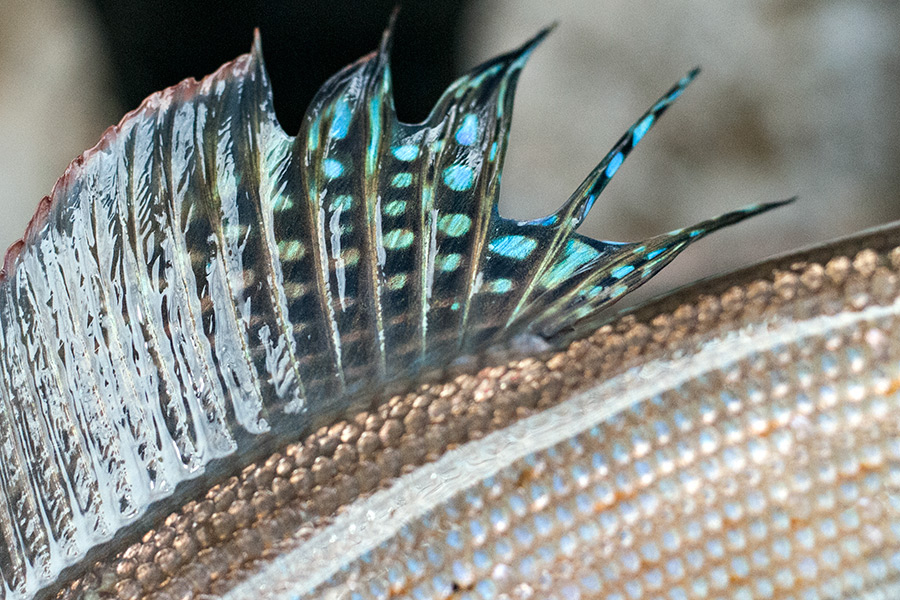Standing knee deep in a watery shoal brimming with thousands of Arctic grayling, biologists Mark Kornick and Tricia Cycz grin ear-to-ear, watching as a sea of brilliant, lacelike dorsal fins shimmers in the dim, gray morning light, a mosaic of teals and textures playing off the water’s surface.
“They look like butterfly wings,” Cycz says. “I call it the most wonderful day of the year, just because it’s such a unique experience. I love doing it.”
Using a net, the Montana Fish, Wildlife and Parks biologists ply the shallow creek that feeds Rogers Lake west of Kalispell and, with effortless aplomb, scoop up a dozen flopping fish, their silvery scales gleaming like chainmail, their fins, dappled in blue-and-green, striking sail-like poses.
“Right now in this creek I bet there are 5,000 of these, and there’s probably more,” Kornick said.
Grayling are an exciting fish to catch, and enthusiastic anglers call them the Lady of the Stream, a striking but modest member of the Salmon family. But Kornick, the FWP’s hatchery manager, and Cycz, a fish culturalist, aren’t capturing the fish for sport – they’re harvesting eggs and sperm from the fish at the peak of their spawning period.
One female, whose fins lack luster compared to the brilliance of her partner’s, which he displays prominently as part of courtship, produces between 2,000 and 4,000 eggs, which are about one-seventh of an inch in diameter, and a single fluid ounce contains 800 eggs; a gallon contains more than 100,000 eggs.
To extrude the eggs, Kornick holds the fish over a bowl and, gripping the tale with one hand, massages her belly as a rich, amber-colored stream of eggs gushes forth. Because each fish contains such a high concentration of eggs, the biologists don’t need many to fulfill their goal of 200,000 fish eggs, which, in several weeks, will yield approximately 150,000 fish.
The biologists then shift their focus to the male fish and, using a similar technique, discharge a sticky jet of semen into the bowl of eggs. They then add water and, within 25 seconds, the eggs are fertilized and the life-forming commixture turns a milky white.
“Within a quarter of a minute, every egg will be fertilized,” Kornick said.
The Montana grayling originally existed only in the tributaries of the Missouri River above Great Falls, and were first documented by Meriwether Lewis and William Clark.
In the early 20th Century the state began stocking Rogers Lake for anglers. But the population was decimated within a few years by an explosion of non-native perch, which were likely planted by a rogue bucket biologist.
Perch reproduce so rapidly they often out-compete other fish, which then stop growing for lack of food.
Rogers Lake, 22 miles southwest of Kalispell, has traditionally been a popular Arctic grayling fishery, and the state agency thought it was important to bolster the grayling populations.
“Historically it’s been a strong grayling fishery and a popular fishing lake,” Kornick said. “We thought it was a good idea to maintain it as a grayling fishery.”
Kornick is proud to still collect eggs from the wild, as opposed to using eggs from domesticated fish brewed in ponds or concrete raceways.
In Montana, the Arctic grayling are currently found in 4 percent of its range, and most native populations exist only in a small area of the Big Hole River near Wisdom.
But in the Flathead, Red Meadow Lake, Handkerchief Lake and nearby Rogers Lake support robust populations.
“It’s like a bridge of fish,” said one observer of the throng of spawning fish.
“They’re beautiful fish,” Kornick said, watching the mob coalesce, dorsal fins emerging from the creek, the surface ebullient as the females release a burst of eggs with a shudder.
“A lot of people claim that the males will lie their fins over the females when they spawn but I don’t really buy it. They do put the dorsal up for show. It’s a big display,” Kornick said. “And when they actually spawn they kind of move together in tandem.”
